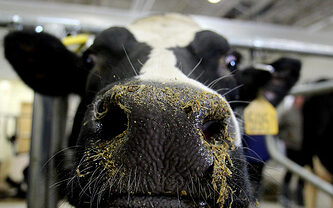Agriculture

How does a changing climate impact Wisconsin agriculture? Some key impacts of a changing climate on agricultural production in Wisconsin include (but are not limited to) increased heat stress on crops and livestock, shifts in pest and disease pressure, longer growing seasons, soil and nutrient loss during heavy precipitation events, challenges with muddy pastures, and more frequent drought occurrence expected in future summers. Resources and experts from UW Division of Extension’s Agriculture Institute and its partners are available to assist farmers and ag advisors in increasing the climate resiliency of Wisconsin farms.

In-season agronomic decision support
The Wisconsin State Climatology Office provides real-time, local information about climate and weather for our state’s agricultural communities to better monitor climatic conditions and manage crops. See frequent updates from the Ag Weather Outlook for Wisconsin, view tools from Extension AgWeather, and access the entire agriculture climate resource dashboard.
Wisconet is a growing network of weather and soil monitoring stations across Wisconsin. Each Wisconet station provides more than a dozen measurements every five minutes, including temperature, precipitation, wind speed, humidity, solar radiation, and soil temperature and moisture at multiple depths. Wisconet now offers an Agricultural Dashboard, featuring location-specific ag weather variables based on data from your closest Wisconet station.

Reports and assessments
The Wisconsin Initiative on Climate Change Impacts (WICCI) Agriculture Working Group produces and shares adaptation strategies for Wisconsin’s diverse agricultural industries through applied research and outreach. The latest report from the Agriculture Working Group was published in 2021 and can be found here.
USDA’s Midwest Climate Hub worked with an array of state-level partners to produce agricultural climate vulnerability assessments for Wisconsin and other Midwest states. These reports cover observed and projected climate trends, impacts on agricultural operations, and management options for adapting to these changes. The report for Wisconsin (published in 2023) can be found here.

Adaptation planning tools
The Climate Ready Farm Assessment tool was created by university experts and Extension educators from across the Midwest to enable farmers to assess the climate vulnerability of their farm. It allows a user to reflect on their current practices and consider ways to reduce the risks posed by a changing climate. Assessments are available for crops, dairy, tree fruit, and swine production systems.
The Climate Adaptation and Mitigation Fellowship (CAMF) project developed a planning tool to guide producers in considering their climate risks/concerns and identify potential practices for their operation. The tool can be used across any farming system and can serve as workspace for farmers to work side-by-side with a trusted advisor to consider practices.
COMET-Planner is a modeling tool that allows a user to get generalized estimates of the greenhouse gas impacts of conservation practices by county. This tool is intended to be used for initial planning purposes as it does not account for site-specific conditions; more advanced users can use the COMET-Farm tool for a more detailed, farm-specific analysis. To learn more, watch this video from WI Land+Water on the basics of these tools.
For questions or more information on climate resiliency resources for agriculture, please fill out the “Ask an Agriculture Question” form to connect with an expert at the UW Division of Extension’s Agriculture Institute. Click here to go to the UW Division of Extension’s Agriculture Institute webpage.

Need help finding something?
Click on the links below to navigate to the Wisconsin Climate Connections page where you can find more resources about:




